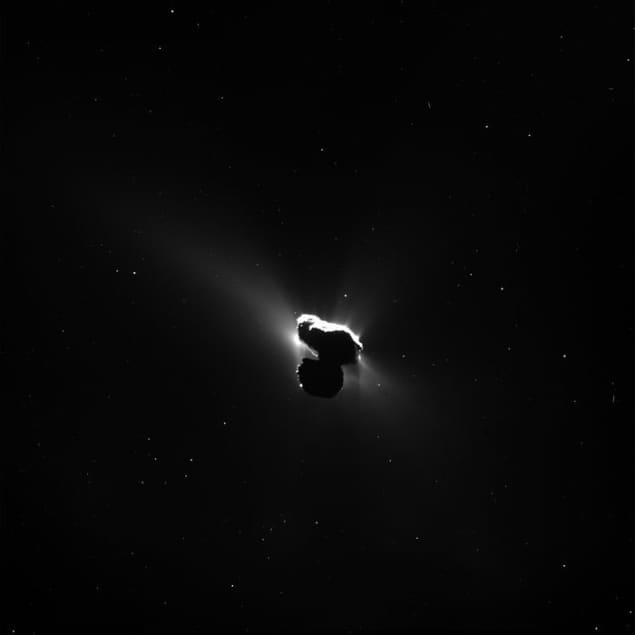
Thanks to in situ measurements from the Micro-Imaging Dust Analysis System (MIDAS) on board the Rosetta spacecraft, researchers have now found out more about the structure of the dust particles on comet 67P/Churyumov–Gerasimenko. Their findings show that the particles are made up of aggregates and cover a range of sizes – from tens of microns to a few hundred nanometres. They also appear to have formed from the hierarchical assembly of smaller constituents and come in a range of shapes, from single grains to larger, porous aggregated particles with some dust grains being elongated. The study could shed more light on the processes that occurred when our solar system formed nearly five billion years ago.
Planetary systems like our own solar system started out as dust particles in protoplanetary nebulae – clouds of gas and dust that gave rise to stars and planets. The particles collided and agglomerated to form planetesimals – the building blocks of planets. Comets are leftover planetesimals and are made of ice and dust particles. They range in size from a few hundreds of metres to ten of kilometres and are mainly found on the outskirts of the solar systems, far from damaging radiation, high temperatures and collisions with other objects.
Pristine particles?
“They are a kind of cold storage,” says team-leader Mark Bentley of the Space Research Institute (IWF) in Graz, Austria, “and so the dust particles they contain should be almost pristine. We hope that these particles can teach us something about the processes of dust agglomeration that took place 4.6 billion years ago.”
“Until now, we have had a hard time trying to understand the very early phases of planet formation,” he adds. “In our solar system, this occurred so long ago, and in other star systems we can only measure the average properties by looking at the way light interacts with dust particles, not study them individually.”
Previous studies to analyse cometary dust include that from the Stardust spacecraft that collected dust particles during its flyby of comet Wild 2. However, the particles here were not pristine as they were collected as far away as hundreds or even thousands of kilometres from the comet’s surface. They would also have fragmented upon their journey and since they were also travelling at more than 6 km/s relative to the spacecraft, they were irrevocably damaged when they collided with Stardust’s sample collector.
Gathering dust
The Rosetta mission, on the other hand, is different in that it provided researchers with the first chance to collect cometary dust “at a ‘walking pace’ rather than a fast fly-by, and the chance to get within a few kilometres of comet 67P/Churyumov-Gerasimenko,” says Bentley. “We obtained our data from the MIDAS instrument on board, which is the first ever atomic force microscope (AFM) to have been launched into space.”

MIDAS collects dust in the vicinity of the comet on small (1.4 × 2.4 mm) targets and then scans them with the AFM to reveal their size, shape and texture in 3D, he explains. The device scans the collected dust particles using a sharp, needle-like tip and produces a 3D image of the particle with a maximum resolution of 4 nm. Unlike a standard AFM, it does not scan its tip continuously over the surface of a sample but carefully approaches the target at each point in the image.
The images show that the dust particles are built from smaller sub-micron grains, themselves apparently aggregates. Such hierarchical structures have only been hypothesised in theory until now and never observed directly.
“Our results also confirm that the grains forming the particles are elongated, which is similar to the shape of interstellar particles measured in remote observations,” says Bentley. “One question is how much of the material that went into building asteroids, planets and comets was reprocessed (melted and reformed for example) as opposed to that which remained as original ‘stardust’, and our results hint that at least some is original material.”
New models
Ludmilla Kolokolova of the University of Maryland in the US, who was not involved in this work, says that the Bentley and colleagues’ new work “enhances our fundamental understanding of cometary dust, and the processes that ultimately gave rise to planetary systems such as the solar system. Their discovery of a hierarchical structure in cometary-dust particles and their description of the basic building blocks of such particles might lead physicists to reconsider the interpretation of data obtained from ground-based observations of comets and re-evaluate the processes in protoplanetary nebulae – and will probably give rise to new models of how planets were formed,” she writes in a related Nature News & Views article.
“The particles described in this study were collected early on in Rosetta’s mission – before the dust density forced the spacecraft to fly farther from the comet (and reduce our chances of collecting more dust),” explains Bentley. “Fortunately, in February this year, we collected a large sample of dust. With only a few weeks left before the orbiter lands on comet 67P, so ending the mission, we are scanning as much of this target as possible to continue the story!”
The research is published in Nature.
- A version of this article first appeared on nanotechweb.org



